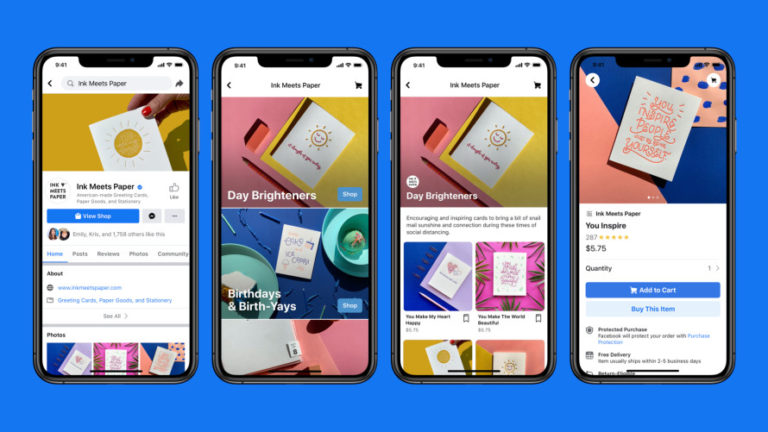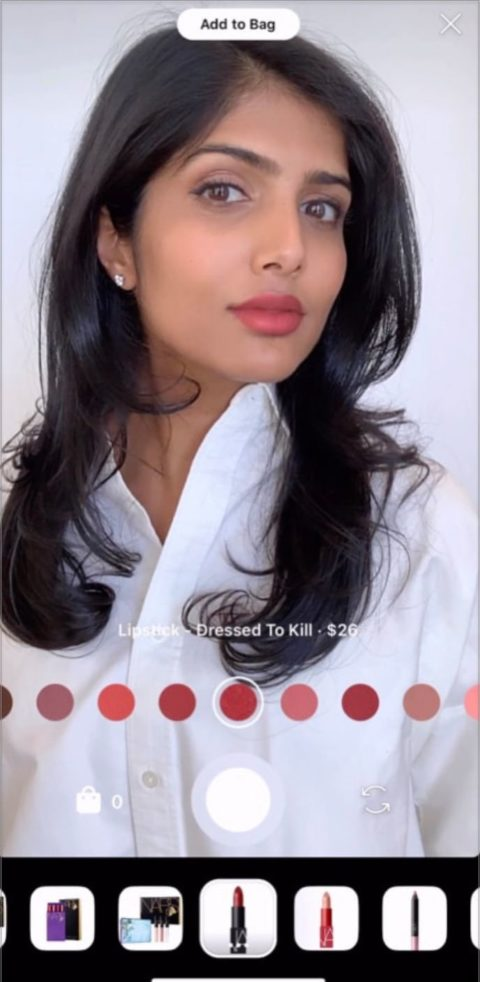Get Ready for Facebook Shops
The COVID-19 crisis has halted businesses globally, forcing many brands to quickly pivot and or move their operations online. In fact, on May 18, Facebook released its State of Small Business report which surveyed 86,000 small businesses in the U.S. and found that 31% of small businesses have stopped operating as a result of the COVID-19 crisis. This is something we’ve seen first-hand with our own clients who have turned to webinars, Instagram Live, and expedited production to meet changing consumer needs. Now, Facebook is helping brands make this shift to digital with the fast-tracked introduction of Facebook Shops.
In a hurry? Give us your email and we will send you a PDF of this post
Facebook Shops 101
This new feature, which is being rolled out to users across the U.S. beginning this week, will allow businesses to sell and advertise products directly through Facebook and its suite of apps. With new features in the works and set to come to fruition later this summer and this year, Facebook Shops is breaking down virtual and monetary barriers, allowing any seller – no matter their size or budget – to bring their business online and take advantage of Facebook’s new and upcoming sophisticated features. Here’s what you need to know:
Who can use Facebook Shops?
Facebook Shops, at the time of publication, is available to any seller who sells physical objects in the U.S. Facebook Shops are free and easy to create, all you need is a Facebook account and Business Page.
Where can users find my Facebook Shop?
Facebook Shops will be linked to your Facebook Business Page and will have a dedicated tab or page that lives in the navigation of your Business Page. Facebook is also rolling out features that will allow you to sell products through its suite of apps including Instagram Direct, WhatsApp, and Facebook Messenger. Soon, you’ll also be able to tag featured products during live broadcasts, such as Facebook and Instagram live.
How do I create a Facebook Shop?
Creating a Facebook Shop, so long as you have an existing Facebook Business Page, is simple and intuitive. Facebook provides step-by-step instructions here, but if you’re already a user of one of the eCommerce apps Facebook is partnering with for this initiative (such as Shopify or BigCommerce) all you have to do is add or install the Facebook add-on and your existing eCommerce store will automatically be integrated with your Facebook Shop.
What do Facebook Shops look like?
However you want them to! In great news for brands, Facebook Shops are highly customizable. Not only can businesses customize the look and feel of their shop with a cover image and accent colors that speak to their brand, but you can also choose and change the products you want to feature.
What is the customer experience like in Facebook Shops?
This is an area we were excited to see Facebook give considerable thought to; Facebook Shops will provide a seamless experience for both the customer and sellers. Facebook users can browse, save, and share your entire shop while in the app or on the site and, if the seller enables it, can even check out on the site too. Customers will also be able to ask questions, get support, track delivery, and so forth directly through Messenger and eventually WhatsApp, Instagram Direct Messages.
Facebook Shops is also looking into ways to make it easier for brands to engage with customers by exploring ways to link loyalty or rewards programs to Facebook accounts. While not available yet, this will allow users to view and redeem brand rewards and perks directly while shopping in the Facebook Shop.
Another customer experience feature that’s in the works but has the potential to be game-changing is Facebook Shop’s artificial intelligence (AI) and augmented reality (AR) tools. In a separate announcement, Facebook shared that new shopping features will include an augmented reality “try on” option, similar to Instagram’s AR feature, where users can catch a glimpse of how products might look in real life.
There will also be AI-driven Shop customization options available in the future to further tailor your customer experience. For example, if you’re a retailer selling items for men and women, you’ll be able to personalize your storefront to show products that are most relevant to the visitor.
How much does Facebook Shops cost?
Facebook Shops are completely free to create and exist but there are some fees for sellers using the eCommerce platform. *Note: As of the time of publication, Facebook is waiving selling fees, subsidizing shipping costs, and providing purchase protection relief until 6/30/2020 in light of COVID-19
First, there’s the selling fee. When you make a sale, Facebook automatically takes 5% from each shipment. For shipments under $8.00, Facebook will take a flat fee of $0.40. The selling fee includes taxes, the cost of payment processing, and “helps fund other programs for a good buying and selling experience.”
There’s also a chargeback fee, though Facebook has yet to provide any details around what that fee might be at this time.
Facebook has indicated that there will be additional fees for using their eCommerce portal, though no further information is available at this time. For now, brands should feel free to begin setting up shop and make a note to re-evaluate in a few months when more news has been published.
What about Instagram?
While not yet available, Facebook also mentioned plans to release Instagram Shops sometime this summer. Instagram Shops will function similarly to Facebook Shops but the user experience will be slightly different.
When Instagram Shops are available, users will be able to browse products directly through Instagram Explore and an “Instagram Shop” button will exist as a permanent button on the navigation bar. According to Facebook’s press release, Instagram Shops will allow users to “browse selections from your favorite brands and creators, filter by categories like beauty and home, and purchase the looks you love all in one place.”
Instagram Shops will also enable product tags in live stories, similar to Facebook.
Facebook Shops: Get Ready
Facebook shops will be rolled out to users in the U.S. over the next several weeks, with global rollout following soon after. Whether Facebook Shops are already available to you or will be soon, here are some things you can begin doing now to prepare:
Make Sure It’s Right for You
Facebook has set parameters around who can sell using Facebook Shops. Before you invest time and effort into creating a beautiful Facebook Shop, make sure you meet the following criteria:
- You must sell physical items; digital items or items available for download are not permitted.
- You must agree with Facebook’s merchant terms and conditions
- You must be able to link to a valid U.S. bank account
- You must be able to provide a U.S. tax ID number
In addition, Facebook holds a high standard for customer service with its Shops. Make sure you’ll be able to meet and accept their conditions:
- All items purchased via Facebook Shops must be shipped to the buyer within three days
- Customers must receive their Facebook Shop purchase no later than 10 days after the order was placed
- Sellers must provide shipment tracking and delivery confirmation
- Customers are permitted to cancel an order within 30 minutes of purchase if seller has not marked the purchase as shipped
- Sellers are not permitted to sell items internationally
Get Active on Facebook and Instagram
First, if you don’t already have a Facebook Company Page established, you’ll need to create one to use both Facebook and Instagram Shops.
If you do have an existing account, make sure you’re updating the page regularly and are sharing content that is of value to your target audience. Now is a great time to experiment with your content strategy and find out what resonates with your audience if you haven’t already done so. In doing so you’ll then have, when your Facebook Shop is ready, an engaged audience of followers and will know which marketing messages work best so you can market your Shop to new users accordingly.
If you need help with your social media content strategy, check out our blog on finding audience insights from social listening, tips for creating effective Instagram stories, whether you should be using IGTV, how to use Instagram’s existing ecommerce capabilities, and how to effectively implement storytelling online and the equation to help you do so.
Make Sure Your Brand Assets are Picture Perfect
From product shots to your Shop’s banners, when you open your Facebook Shop you’ll want to make sure it’s on-brand, clean, and sharp looking.
Determine the brand colors, fonts, and graphics or imagery you’ll want to display. Keep in mind, these shops will be linked and found through the navigation of your Facebook Company Page so you’ll want to take into account the look and feel of your existing page and ensure there’s consistency between both.
Don’t forget to get your product photos, titles, and descriptions queued up and ready to go for when your Shop is available to go live. Below are some tips for each:
Product Photos
Facebook will allow you to upload up to 10 images per product – so definitely take more than one. Make sure you capture the photo from every angle as well as from a distance and up close. Facebook recommends using a white backdrop so the item is easy to see but we’d also recommend including a photo that captures how the product is used in real life, such as a model wearing a t-shirt.
You should also keep in mind Facebook’s photo recommendations, which include square photos at a resolution of 1024×1024 pixels without watermarks, graphics, or text.
Product Titles and Descriptions
As with most marketing messages, you want to make sure your titles and descriptions are descriptive, compelling, and draw the users’ attention quickly. Don’t be afraid to add your brand’s personality to the tone and voice of your descriptions, but be wary of Facebook’s stringent standards which we’ve outlined below:
- Titles have a maximum length of 150 characters; the recommendation is to use under 65 characters.
- Titles should read naturally without extra words or keyword stuffing
- Descriptions must be between 30-5,000 characters
- Avoid using all caps, excessive punctuation, HTML, and links as users may think your product is spam
- Avoid long paragraphs or bullets, per Facebook guidance
- Don’t include shipping or contact information; Facebook Shops have its own place for this kind of information
We recommend building these out in a spreadsheet for easy upload and implementation when you’re ready to publish your Facebook Shop.
Experiment with Ads
If you aren’t already doing so, now is the perfect time to begin experimenting with Facebook and Instagram ads. There are a few reasons why we recommend doing so:
- Saturation: Given the current climate of the world, once this rolls out across the entire country and world, the Facebook Shops market is going to become very saturated, very quickly. Get ahead of competitors and start getting your brand name out there while learning what messages and strategies resonate with your audience best.
- Machine Learning: Facebook ads tend to perform better the longer you run them; Facebook’s algorithm improves as users interact with your ads, getting closer to putting the right message in front of the right people at the right time as it has more data to learn from. Get a jump start on competitors in finding exactly who is the right audience for you
If you need help conceptualizing, implementing, and managing Facebook ads, we can help.
Solidify Your Instagram #Hashtag Strategy
While Instagram Shops isn’t a feature yet available, when it does arrive, every brand is going to be looking for ways to get to the top of Instagram’s “Explore” shopping page. This page already exists and currently operates by curating content based on a user’s interests based on previous activity, the people they follow. This page will continue to operate in the same way as it relates to populating users’ pages with products.
Much of what Instagram bases a user’s interest on is not just the people they follow, but the content they interact with. And how do they group this content to determine what other content may interest a user? With hashtags. Instagram hosts hundreds of thousands of varieties of hashtags – and they cover everything from the super-niche to today’s most popular trend. #RosaceaSkincare? Sure. #JustinBeiber? Definitely.
You’ll be several steps ahead of competitors if you can identify the hashtags that resonate most with users now. Experiment with different hashtags on your posts and see if you can spot a trend. For example, if you’re a clean beauty company, see if one post with the hashtag #cleanbeauty performs better or equal to another using #veganbeauty. It’ll take some time and it’s not a perfect science, but defining the categories that are most likely to convert will help you save time wasting content on an audience that’s not right for you, as well as help you reach the coveted explore page. Instagram scheduling company Later has a great blog with tips for creating a hashtag strategy that we’d recommend reading.
Meet your customers where they are has been the Golden Rule in business for decades, so it’s no surprise that Facebook has finally made the leap to help businesses do just that. While this feature may have been fast-tracked in light of COVID-19, this new tool is set to change the trajectory of eCommerce for the foreseeable future. As Mark Zuckerburg said in his live announcement, “I think we’re going to continue living more of our lives online and doing more business online.” We can’t help but agree.
For more resources on shifting your business strategy to digital, try one of our blogs or reach out for help:






